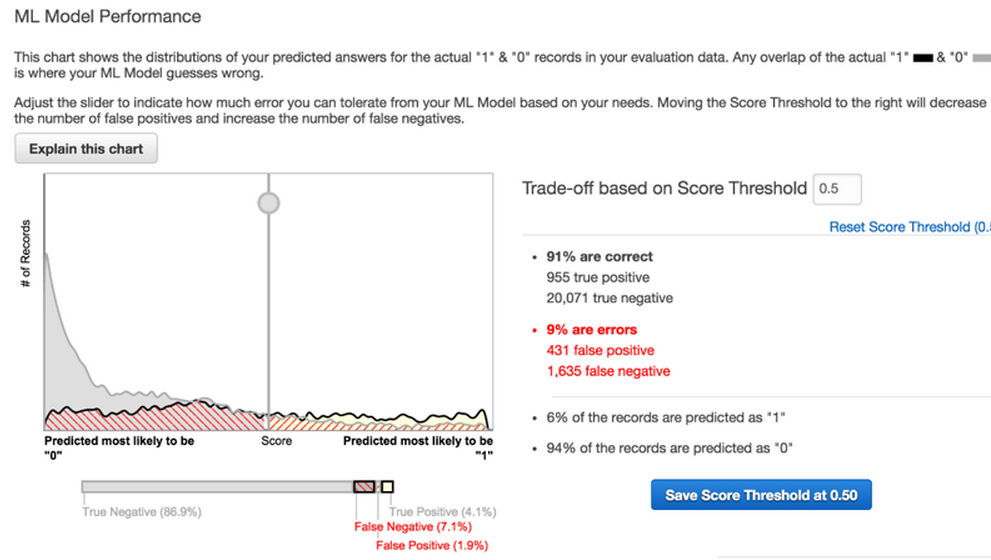
Can Amazon Make Machine Learning More Accessible?

First we had IBM Watson Analytics, then Microsoft launched Azure Machine Learning. With last week’s launch of Amazon Machine Learning, the e-commerce giant is the latest tech giant to attempt to democratize the development and use of machine learning models and make the technology useful to people who aren’t data scientists.
“Have you noticed how applications seem to be getting smarter all the time?” Amazon says in a video on its website. Banks alert you when there is a suspected fraudulent transaction in your account, and stores make recommendations of new products that are similar to ones you previously purchased. “These are examples of ways you can use a technology called machine learning.”
Amazon, of course, has long relied on machine learning technology to optimize its website (the seventh most popular in the world) and to bolster its $89 billion e-commerce business. Now the company says it’s taking that same machine learning technology and making it available via its new Amazon Machine Learning offering.
The new Amazon ML offering is designed to make it easy for users to create machine learning models that describe their existing data sets, and then deploying those models to make predictions on new data coming in. With Amazon ML, Amazon Web Services does the hard work of running and managing the underlying infrastructure, thereby freeing users from worrying about how to scale their predictive systems.
Amazon ML makes liberal use of wizards and other productivity boosters to help users begin their machine learning journey. Interactive charts accessible through a Web browser help users understand the data they’re using to train their models, including spotting incorrect or missing data attributes. Users can select from a list of pre-built data transformations, or build their own transformations.
The service supplies the underling algorithms for making three types of predictions, including binary classification, multiclass classification, and regression. Not only does Amazon ML help the users create the models, but it guides them through the sometimes tedious task of evaluating their effectiveness and fine-tuning the models to increase their effectiveness. Interactive visualizations help users see how the models are performing for certain use cases, and suggests tweaks that can boost effectiveness and performance.
Once users have built and refined their models, Amazon helps them deploy the models, either in batch or in real-time, through simple APIs. Potential use cases include fraud detection, demand forecasting, predictive customer support, click prediction, content personalization, document classification, churn prediction, and propensity modeling for marketing campaigns.
The batch API can generate billions of predictions, the company says, while the real-time API feeds predictions continuously with low latency. Amazon ML capabilities can be embedded into just about any application via the AWS Software Development Kits (SDKs) for Java, .Net, Python, PHP, Ruby, and Node.js. Users can also embed ML capabilities into mobile apps via the AWS SDK for Mobile.
Machine learning is the workhorse of today’s big data analytics, but it typically requires data science skills and access to large amounts of computing power to pull it off successfully. Not Amazon ML, says AWS chief evangelist Jeff Barr.
“You can benefit from machine learning even if you don’t have an advanced degree in statistics or the desire to setup, run, and maintain your own processing and storage infrastructure,” Barr writes in a blog post.
Amazon ML just launched last week, so there aren’t a lot of data points available to make predictions about its potential for success. But there are several early adopters, including Jan Neumann, who heads up a data science research team at media giant Comcast.
“We evaluated Amazon Machine Learning and found it to be a compelling offering for our data science analytics,” Neumann says. “We particularly liked the ability to visually explore the tradeoff between parameter settings and classification performance during the evaluation…. [I]t was quite simple to prepare and clean the input data and train a model on large data sets in short order.”
One developer who works at Amazon itself was able to solve a problem in 20 minutes that previously took two developers 45 days to solve, according to Amazon. “None of these developers had prior experience in machine learning, and both models achieved the same accuracy of 92 percent,” the company says.
The new ML service is sure to generate a lot of interest, especially considering how many organizations store data in Amazon Web Services. Amazon ML has connectors for various AWS repositories, including S3, the Redshift data warehouse, and hosted MySQL databases via Amazon Relational Database Service (RDS).
Users pay nothing to get started with the service, and the price ramps up depending on what the users do with it. Data analysis, model training, and model evaluation costs $0.42 per compute hour. Batch predictions will cost $0.10 for every 1,000 predictions. Real time predictions will also cost $0.10 for every 1,000 predictions, in addition to an hourly reserved capacity charge of $0.001 per hour for each 10 MB of memory provisioned for your model.
It will be interesting to see how much traction Amazon gets with the new machine learning cloud service. There is a growing demand for using machine learning algorithms to power predictive applications. Amazon isn’t the only vendor chasing this opportunity, obviously. But if it can succeed in boiling some of the complexity out of it, it may just have another winner on its hands. For more info, see the Accessing Amazon Machine Learning guide.
Related Items:
The 3 Key Steps to Building a Predictive App with Machine Learning
Achieve Business Value with Machine Learning
Inside Sibyl, Google’s Massively Parallel Machine Learning Platform
































